Random Cards Mac OS
They are out there in abundance, I just don't have any clue which ones work with Mac OS X. Posted by Freen at 9:58 AM on August 7, 2007 Try a listed third-party, high-powered card with the open source OS X wireless driver.
Random Cards Mac Os 7
EDIT: This post have been getting very many views lately so ‘fess up in the comments if you want a part 2 with more advanced and new ways to use Mac OS X commands and wildcard characters.
This tip/post is going to be about several common Mac OS X commands and wildcard characters I have discovered, at work, that is useful to understand and know how to use. First off, wildcard characters are special characters such as * and ? that help you to find groups of filenames that have something in common.
Go to frree4alldevices and download the desired Mac OS version image file. This is new link and it is. The size of the state array (in bytes) is used by initstate to decide how sophisticated a random number gener-ator generator ator it should use - the more state, the better the random numbers will be. (Current 'optimal' values for the amount of state information are 8, 32, 64, 128, and 256 bytes; other amounts will be rounded down to the. Export vCard – This will generate a VCF (vCard) file with all contact information stored within the app, a vCard file is a universal standard and would be the most compatible with many platforms, including other Mac OS X apps, iOS, Windows, Android, Blackberry, etc – recommended for maximum compatibility of stored contact information, especially for backups.
For example, say I have a couple of files that I want to find in my home directory. My home directory is cluttered with junk files that I never take the time to organize. But somewhere within that junk pile of files there lay 8 files I would like. Their filenames are ssw_idl.a285, ssw_idl.r391, ssw_idl.z988, ssw_idl.c293, and the other 4 files are named similarly (“ssw_idl.” followed by a letter, then 3 numbers).

Open up terminal (or something similar like X11’s xterm) and type in ls
Cramming time:cd – changes directories (directories = folders). cd .. to go up a directory and cd FOLDERNAME to go to a folder in the current directory.rm – deletes files/folders.mkdir – makes directories (folders).say 'Hello!' – computer says ‘Hello!’more textFileName – opens up a text file for viewing inside the command line/shell.
Now the actual reason I wrote up this post was to show you how to display only certain files with similar names. So we’ll go on to learn about wildcard characters (to be completely honest, I am a noob to this whole wildcard thing; I am stilling learning also), and then about how to use wildcard characters in the Mac OS X command line. Skip ahead if you already know about wildcard characters.
——– The Good Stuff ——-
* – this star means “everything”.ls * will display all folders and all files within those folders.? – means any character. ?? means any two characters. So basically ls ??* will only display files/folders that have filenames 2 or more characters long.alphabet and numbers – typing in any letters or numbers means that files/folders must have those exact letters/numbers.ls *.jpg – lists all files that are jpeg images (.jpg extension)
The “.” (backslash then dot with no space, in case you couldn’t see it well) means a literal dot. No backslash before the dot would mean just any single character except for a new line (n).ls a* – lists files/folders starting with an “a”.ls *.* – lists only files because folders don’t have a dot in their name.ls [a-z] – lists only folders with a one character letter for their name.ls frame[0-9] – lists any files/folders starting with “frame” and then any 1 number.
Random Cards Mac Os X
A very nicely made reference page for Mac OS X Commands:
http://www.ss64.com/osx/
Random Cards Mac Os Catalina
Any comments welcome! Show me something cool & new!